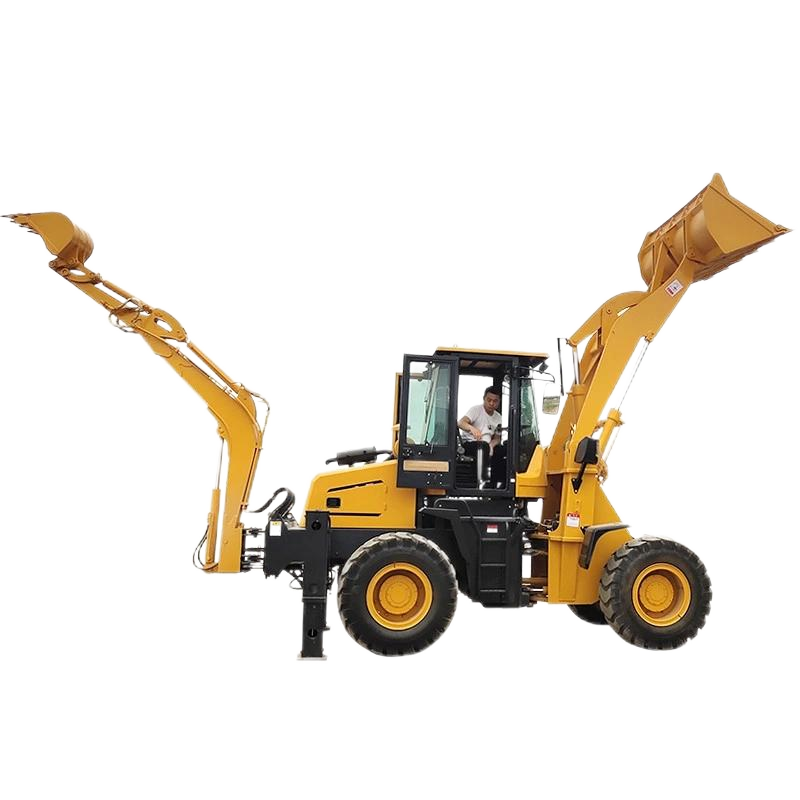A backhoe loader, also known as a "two-way machine", is a multi-functional construction machinery that integrates loading and excavating functions. It gets its name because it is equipped with a loader bucket at the front and an excavator bucket (or other working devices) at the rear. Combining the efficient loading and unloading capacity of a loader with the excavating capacity of an excavator, it is widely used in scenarios such as small-scale engineering, municipal maintenance, agricultural production, and rural construction, and is particularly suitable for environments with narrow spaces and diverse operation contents.

The structural design of a backhoe loader takes both operation functions into account, mainly consisting of the following parts:
- Chassis: It bears the weight of the whole machine, usually adopting a wheeled walking mode (a few are tracked), ensuring a certain degree of mobility and passability, and is suitable for driving on non-hardened sites or rural roads.
- Front working device: The standard configuration is a loader bucket, which can be quickly replaced with accessories such as a fork or a dozer blade, used for loading and unloading sand, earth, materials, etc.
- Rear working device: The standard configuration is an excavator bucket, which can be replaced with a breaker, a wood grabber, a drilling machine, etc., used for excavating foundation pits, ditches, breaking stones, etc.
- Power system: Most adopt diesel engines with a power usually ranging from 30 to 100 horsepower (about 22-75kW), adapting to small and medium-sized operation needs. Some models can automatically adjust power output according to the load.
- Operating system: Equipped with two sets of independent control devices, which control the front loading and rear excavating actions respectively, featuring flexible operation and convenient switching.
- Multi-functionality: One device can complete various operations such as loading, excavating, dozing, breaking, and handling, without the need for frequent equipment replacement, greatly improving the operation efficiency of small-scale projects.
- Strong flexibility: The overall size is small (usually 5-7 meters in length and 2-3 meters in width) with a small turning radius, suitable for operations in narrow spaces (such as rural courtyards, lanes, and small construction sites).
- Good mobility: The wheeled design allows it to drive directly on roads (at a speed of about 20-40km/h), making it convenient to transfer without relying on trailers.
- Cost advantage: Compared with purchasing a loader and an excavator at the same time, the purchase and maintenance costs of a backhoe loader are lower, making it suitable for small and medium-sized engineering teams or individual users.
- Small infrastructure projects: Such as rural road construction (excavating subgrades, loading sand and gravel), excavation of small house foundations, and material transfer.
- Municipal administration and maintenance: Renovation of urban green belts (excavating tree pits, transporting seedlings), excavation of sewers, road maintenance (breaking pavements, loading waste).
- Agriculture and forestry: Excavation of farmland irrigation ditches, transportation of crop straw, loading and unloading of wood in forest farms, etc.
- Emergency rescue: Clearing obstacles and excavating channels at small disaster sites (such as rural landslides and small collapses).
| Comparison Dimension | Backhoe Loader | Standalone Loader | Standalone Excavator |
|---|
| Function | Loading + Excavating + Multi-functional Accessories | Only loading (simple accessories can be replaced) | Only excavating (accessories such as breakers can be replaced) |
| Applicable Scenarios | Small-scale, multi-task scenarios | Large-scale loading operations | Large-scale excavating operations |
| Efficiency | High comprehensive efficiency, suitable for small-batch operations | Higher loading efficiency | Higher excavating efficiency |
| Cost | Low single-unit cost, high cost performance | Lower cost for single function | Higher cost for single function |
| Mobility | Convenient transfer, suitable for narrow spaces | Convenient transfer, suitable for open spaces | Transfer depends on trailers, poor flexibility |
- Matching operation needs: If the main task is loading with occasional excavating, a model with stronger front-end power can be selected; if there is a higher demand for excavating (such as deep ditches, hard soil), attention should be paid to the power and excavating depth of the rear excavating device.
- Accessory compatibility: Priority should be given to models that support multiple accessories (such as breakers, wood grabbers) to improve equipment utilization.
- Maintenance convenience: Choose brands with simple structures and easily available accessories to reduce later maintenance costs.
- Operation training: Since it is necessary to switch between two operation modes, operators need to be familiar with the coordinated control of the front and rear devices to avoid equipment damage or safety risks caused by misoperation.
In conclusion, relying on the characteristic of "one machine with multiple uses", backhoe loaders have become an ideal choice for small and medium-sized projects and multi-scenario operations, and the demand for them continues to grow especially in fields such as rural revitalization and small-scale infrastructure.






